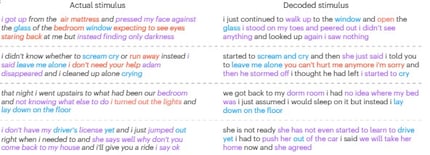
Neuroscience: Mind reading with brain scans
Based on the GPT language model, a neuroscientific team has developed a new method for reading thoughts. The AI captures the essence of what people are thinking - but only if they want it to.
In their new study "Semantic reconstruction of continuous language from non-invasive brain recordings", scientists from the University of Texas present a new method that makes it possible to read the thoughts of test subjects without surgical intervention. Comparable attempts to put thoughts into words were previously only possible to a limited extent, as the systems were restricted to a limited vocabulary. The new approach is now based on a language model that was created with GPT and thus enables a continuous flow of words.
From blood flows in the brain to formulated thoughts
For the study, three test subjects had their brain waves recorded in an MRI scan for 16 hours. The test subjects listened to podcasts while lying in the MRI machine, while the changes in their brain's blood flow were recorded as an indicator of brain activity. Using this neuronal data, the scientific team was able to assign the patterns of brain activity to specific words or ideas with the help of GPT. Once it was clear which brain activity patterns matched the words in the stories, the team was able to work backwards. They then used the brain patterns to predict new words and ideas.
The system works iteratively, just like ChatGPT: it evaluates the probability of words that appear after the previous word in order to determine the most probable one based on the brain activity patterns and thus capture the basic idea of the thought. It therefore does not literally reproduce the thoughts of the test subjects, but reveals the core of what was thought.

Source: //doi.org/10.1038/s41593-023-01304-9
Will thoughts soon no longer be safe?
As fascinating as these advances are, they could also pose a threat to the privacy of our thoughts. The researchers address this topic in their publication and are able to allay concerns: The new method cannot be used universally, but is always individually tailored to the brain activity with which it was trained. This means that only the thoughts of the person whose blood flows in the brain were used for the development can be decoded. In addition, the person must cooperate voluntarily so that the system can recognise ideas. If, for example, the content of an audio story was to be decoded, but the test subject was not paying attention to the story or was consciously thinking about something else, it was not possible for the system to recognise the content of the audio story.
Caption photo: pressmaster/shutterstock
Science editor and biologist. I love animals and am fascinated by plants, their abilities and everything you can do with them. That's why my favourite place is always the outdoors - somewhere in nature, preferably in my wild garden.
From the latest iPhone to the return of 80s fashion. The editorial team will help you make sense of it all.
Show all